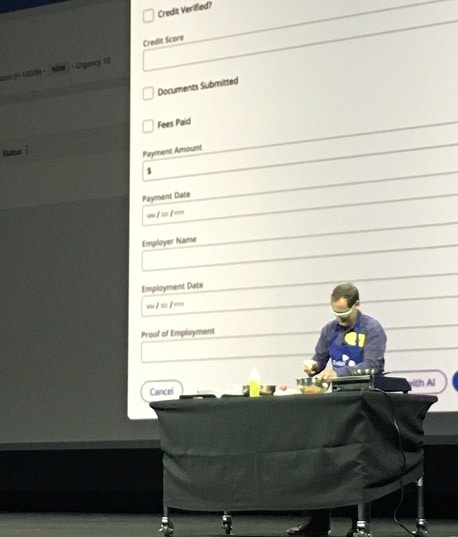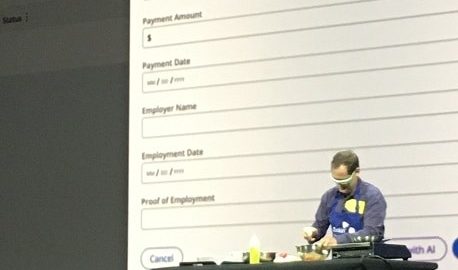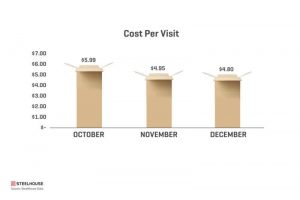In addition to the latest product announcements, Pega this week outlined a vision for an AI-powered self-optimizing enterprise.
“It’s clear to us that we are in a revolutionary moment,” said Pega founder and CEO Alan Trefler at the PegaWorld conference in Las Vegas this week. “The emergence of AI in new ways is complementing our traditional view of AI and creating enormous opportunities and risks.”
So far, so familiar; similar announcements have been made at numerous marketing technology conferences this season. But here’s where Pega sees the revolution leading us: the continually optimizing enterprise, or, as Pega tags it, the “autonomous enterprise” — the enterprise that uses the full range of AI and automation to teach itself better processes, systems and business logic.
In other words, the enterprise as a self-driving car.
“There are opportunities in a business to make portions of the business self-optimizing,” Pega CTO Don Schuerman told us. “Right now, I may set some high-level business goals, but I then have to flow those goals through multiple layers of organization structure and technology to get to the actual system that implements it. Either that process is too slow to keep up with the goals or the goals get diluted.”
Alternatively, process mining AI (AI-driven understanding of businesses processes) plus analytical and predictive AI — combined with generative AI — can in effect declare a goal “and let the systems tune themselves toward that goal.” That doesn’t mean the AI makes automatic changes without a human in the loop.
The Pega way
PegaWorld iNspire 2023 coincided with Pega’s 40th anniversary. It was founded by Alan Trefler, then a twenty-seven year old chess master who believed techniques used to teach computers to play chess could be applied to business process modeling (BPM). Pegasystems, as it was then known, added customer decisioning, CRM and CX capabilities in the 2010s.
Originally, Pega used AI to power case management in the BPM space. It duplicated this capability in its CX offering to create 1:1 real-time customer journeys through its Customer Decision Hub, which essentially suggests the next-best-action (at the right time, in the right channel) for individual customers, based on countless behavioral data points.
Trefler views this approach as diametrically opposed to the widespread strategy of creating customer journeys that anticipate the behavior of audience segments. “I still run into people who want to talk about audiences and segments — which goes back 35 years to database marketing,” he told a press panel. Pega’s capabilities, he insists, creat responses to every individual and every opportunity.
“Most marketing is remarkably unevolved,” he continued. “It just leads to the customer being spammed; it’s dreadful.”
New AI vs. traditional AI
The explosion of generative AI creates challenges — and perhaps opportunities — for a vendor like Pega that has had other types of AI (the predictive AI of customer decisioning, for example) in its DNA for years. Indeed, Pega is proud that it anticipated generative AI — the in-house AI guru Dr. Rob Walker demonstrated text and image generation at PegaWorld in 2017 and 2018.
This year, however, competitors like Adobe and Salesforce jumped out ahead of Pega in announcing gen AI solutions like Adobe Firefly and Einstein GPT. Trefler was unphased. “I’ve seen many BS cycles, hype cycles and exaggeration cycles,” he said. “All software companies claim they can do anything. We have an exciting technology,” he said, “and people are trying to associate themselves with it.” He emphasized that he was not calling generative AI itself “BS.” “There’s an enormous upside,” he said, predicting that “a lot of roles in companies will change very materially.”
Last month, Pega announced Pega GenAI, a set of 20 generative AI-powered boosters to be integrated across the Pega Infinity ‘23 platform release. The boosters include:
- A treatment creation assistant in Pega Customer Decision Hub will help users produce better treatments by providing text and image suggestions.
- Automatic interaction summaries in Pega Customer Service along with accelerated chatbot training and a customer interaction simulator.
- Email reply and meeting summary generators in Pega Sales Automation.
Peter van der Putten has been involved with AI and decisioning at Pega for some 12 years and currently serves as director of Pega’s AI Lab. He told us: “We’ve been discussing the opportunity for generative AI at Pega way before ChatGPT came out. People who have been around a long time tend to roll their eyes a little bit; we’ve been doing this forever. But there is a major change. It’s often that the adoption of a technology lags behind the invention of a technology, sometimes by a substantial time.”
Previously, much AI in martech had been used for what van der Putten calls “left brain” activities — optimal rational decision-making, real-time contextual next-best-action (who can we target with the right offers?) — while generative AI gives you “right brain” capabilities — creative AI. “That’s a lot of fun.”

It’s important to understand that Pega is not building its own large language models (LLMs). Rather, it’s providing an à la carte selection of third-party models (from OpenAI, Google, Amazon and others) that also afford the opportunity for businesses to train them on their own data (as we did with MarTechBot).
“We provide this architecture where we can centrally manage your gen AI,” explained van der Putten. “In other words, you can have all kinds of workflows and processes and applications. Behind it, I can define what kind of service I want to use. Do I want to use an OpenAI model or a Google model — we’re a trusted tester with Google, so we get early previews — or a model through AWS, and fine tune the models on our own data.”
These back-end business choices are hidden from the user-facing applications that simply require a natural language prompt. As the gen AI ecosystem changes, so can those choices. The user draws on the generative power of these existing LLMs without stepping out of their Pega workflow.
“It doesn’t really feel like ChatGPT,” he said. Using the capabilities (20 so far) shipped with Pega Infinity ’23, user prompts can generate much more than text responses. “If you say, I want to build a loan application, it generates the entire output. You don’t just get text returns, you get the application.” It’s going beyond typing a question in a box and getting an answer, he explained.
“The technology market doesn’t do nuance well,” said Schuerman. “But it does hype well. Generative AI has its lane, but so do predictive models. Where I think things like generative AI help is, if I can feed into a little bit of that buzz and hype-cycle to open the door to a conversation. We have press releases about gen AI and we get hands raised from clients, but what we actually end up talking to them about is next-best-action — because that’s what they actually need to solve their problem.”
Pega, says Schuerman, is thinking of preparing a statement on AI to help clients understand it. “One of the headlines will be: There is more to AI than large language models.”
What’s in it for marketers?
The developments Pega described have implications across the enterprise — for AI-driven business process mining as well as for CX. What do they mean for marketers. We spoke to Tara DeZao, Pega’s product marketing director for martech and adtech.
“When it comes to the autonomous enterprise — for everyone in the organization, but especially for marketers — it’s all about scale,” she said. “I was at a conference last week and a very big vendor was there. They have a product catalog of 1500 products. They were running approximately 300 campaigns at any one time. I don’t know any humans that can run 300 campaigns at one time and have that go smoothly.”
What AI-backed autonomy does, she continued, is help marketers reach more people, more efficiently, more quickly — and more cheaply — whether through campaigns or 1:1 next-best-action engagement.
“You might need to make a change in your copy on an ad unit. Back in the marketing olden days, you’d have to pull the ad unit down, you’d have to go back to creative, get the new copy approved, launch it, then maybe two weeks later you get results back.” With autonomy, she said, you can pivot instantly.
And Pega GenAI? “Marketers should be excited about generating treatments on the fly, being able to produce new content when needed, finding under-served audiences and populations and engaging them, and understanding if its all working way more quickly than you would in a typical campaign context.”
Marketing organizations will be confront with the challenge of building the right skill-sets for this new world. “It’s retaining the talent they have and re-training them, and it’s finding enough resources to backfill positions,” she said. “We’ve gone from human-based foundations to self-learning over a period of time and marketers have had to evolve, so it’s a question of what investment organizations can make in their teams.”
Ultimately, said DeZao, AI can reduce costs across organizations. “Wouldn’t it be great if those cost savings could be re-invested in employees?”
Other announcements at PegaWorld
At PegaWorld, further details of the Pega Infinity ’23 release were fleshed out:
- A reuse library in the low code App Studio to support easy discovery of reusable components such as pre-built business logic, integrations and AI models.
- Enhanced accessibility compliance in out-of-the-box features.
- One-Time Actions to quickly create new messages to address specific needs of specific audiences (e.g. emergency notifications.
- AI-built simulated customers to help speed customer service agent training.
Pega also announced the availability of its Pega Cloud solutions on Google cloud as a managed as-a-service offering. Pega Cloud is also now available in Google marketplace. This continues Pega’s commitment to cloud choice; although Pega on-prem solutions are still supported, Pega believes that its cloud solution enables more rapid and flexible deployment of its solutions.
Pega also released research based on interviews with 600 business decision-makers in the U.S. and Europe, 96% of whom said they plan to fully embrace the autonomous enterprise within the next 10 years.
The post Pega: AI will power the autonomous enterprise appeared first on MarTech.
MarTech(7)




